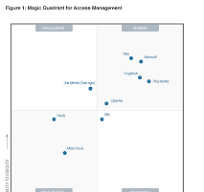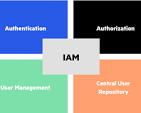The Significance of Gartner Identity and Access Management Magic Quadrant
Every year, technology research and advisory firm Gartner releases its highly anticipated “Magic Quadrant” report for various sectors within the IT industry. One such report that holds significant importance for organisations worldwide is the Gartner Identity and Access Management Magic Quadrant.
The Gartner Identity and Access Management Magic Quadrant evaluates different vendors offering identity and access management solutions based on their completeness of vision and ability to execute. The report provides a comprehensive analysis of the IAM market, including key trends, challenges, and recommendations for businesses looking to enhance their security posture.
Key Components of the Magic Quadrant
The Magic Quadrant categorises IAM vendors into four quadrants: Leaders, Challengers, Visionaries, and Niche Players. Vendors are positioned based on their strengths and weaknesses in delivering IAM solutions that meet the evolving needs of organisations in terms of security, compliance, scalability, and user experience.
Benefits for Organisations
For organisations seeking to invest in IAM solutions, the Gartner Identity and Access Management Magic Quadrant serves as a valuable resource. It helps businesses make informed decisions by providing insights into market trends, vendor capabilities, product offerings, and competitive landscapes. By referencing the Magic Quadrant report, organisations can align their IAM strategies with industry best practices and select vendors that align with their specific requirements.
Future Implications
As cybersecurity threats continue to evolve rapidly, the role of identity and access management becomes increasingly critical for safeguarding sensitive data and maintaining regulatory compliance. The Gartner Identity and Access Management Magic Quadrant will play a pivotal role in guiding organisations towards selecting robust IAM solutions that can adapt to emerging security challenges.
In conclusion, the Gartner Identity and Access Management Magic Quadrant serves as a benchmark for evaluating IAM vendors’ capabilities and provides valuable insights for businesses navigating the complex landscape of identity management. By leveraging this authoritative report, organisations can enhance their security posture and effectively manage access to digital resources in an increasingly interconnected world.
7 Essential Tips for Navigating the Gartner Identity and Access Management Magic Quadrant
- Understand the evaluation criteria used by Gartner in the Identity and Access Management Magic Quadrant.
- Compare different vendors’ positions on the quadrant to identify leaders, challengers, visionaries, and niche players.
- Consider the specific needs and requirements of your organisation when interpreting the quadrant.
- Look beyond just the quadrant placement and delve into the detailed reports for more insights.
- Stay updated with the latest releases and updates from IAM vendors to make informed decisions.
- Seek feedback from other organisations using IAM solutions to understand real-world experiences.
- Engage with Gartner analysts for personalized advice on selecting the right IAM solution.
Understand the evaluation criteria used by Gartner in the Identity and Access Management Magic Quadrant.
To maximise the benefits of the Gartner Identity and Access Management Magic Quadrant, it is crucial for organisations to thoroughly understand the evaluation criteria employed by Gartner. By grasping the key metrics and factors that Gartner considers when assessing IAM vendors, businesses can make informed decisions aligned with their specific needs and objectives. Understanding the evaluation criteria enables organisations to interpret vendor positioning accurately within the Magic Quadrant and select a provider whose offerings best match their requirements for robust identity and access management solutions.
Compare different vendors’ positions on the quadrant to identify leaders, challengers, visionaries, and niche players.
When utilising the Gartner Identity and Access Management Magic Quadrant, it is essential to compare the positions of various vendors within the quadrant to distinguish between leaders, challengers, visionaries, and niche players. By analysing the placement of vendors based on their completeness of vision and ability to execute, organisations can gain valuable insights into the strengths and weaknesses of each vendor’s IAM solutions. This comparative approach enables businesses to make informed decisions when selecting a vendor that aligns with their specific requirements and strategic objectives in the realm of identity and access management.
Consider the specific needs and requirements of your organisation when interpreting the quadrant.
When delving into the insights provided by the Gartner Identity and Access Management Magic Quadrant, it is crucial to bear in mind the advice to consider the specific needs and requirements of your organisation. While the quadrant offers a valuable overview of IAM vendors and their capabilities, each business has unique challenges, goals, and compliance standards that must be taken into account. By aligning the quadrant analysis with your organisation’s individual context, you can make informed decisions that best suit your security objectives and operational demands. This tailored approach ensures that the chosen IAM solution not only meets industry standards but also addresses the specific intricacies of your organisation’s identity and access management needs.
Look beyond just the quadrant placement and delve into the detailed reports for more insights.
When utilising the Gartner Identity and Access Management Magic Quadrant, it is essential to look beyond merely the quadrant placement and delve into the detailed reports for deeper insights. While the quadrant positioning provides a high-level overview of vendors’ performance, the detailed reports offer a wealth of information on each vendor’s strengths, weaknesses, market presence, and strategic direction. By thoroughly examining these detailed reports, organisations can gain a comprehensive understanding of the IAM landscape and make well-informed decisions that align with their specific security requirements and long-term goals.
Stay updated with the latest releases and updates from IAM vendors to make informed decisions.
To make informed decisions regarding identity and access management solutions, it is crucial to stay updated with the latest releases and updates from IAM vendors. By keeping abreast of new features, enhancements, and security patches offered by vendors in the Gartner Identity and Access Management Magic Quadrant, organisations can ensure that their IAM strategies remain effective and aligned with industry best practices. Regularly monitoring vendor updates also allows businesses to leverage cutting-edge technologies and address emerging security threats proactively, ultimately enhancing their overall cybersecurity posture.
Seek feedback from other organisations using IAM solutions to understand real-world experiences.
To maximise the benefits of utilising the Gartner Identity and Access Management Magic Quadrant, it is advisable to seek feedback from other organisations that have implemented IAM solutions. By engaging with peers who have first-hand experience with these technologies, businesses can gain valuable insights into real-world challenges, successes, and best practices. Understanding how IAM solutions perform in diverse operational environments can help companies make informed decisions and tailor their implementation strategies to align with industry standards and user requirements. Feedback from other organisations serves as a practical guide for enhancing security measures and optimising IAM processes based on proven experiences in the field.
Engage with Gartner analysts for personalized advice on selecting the right IAM solution.
Engaging with Gartner analysts for personalised advice on selecting the right Identity and Access Management (IAM) solution can be a game-changer for organisations looking to enhance their security posture. By tapping into the expertise of Gartner analysts, businesses can gain valuable insights tailored to their specific requirements and challenges. This personalised guidance can help streamline the decision-making process, ensuring that the chosen IAM solution aligns closely with the organisation’s goals, budget constraints, and technical capabilities. Ultimately, leveraging the expertise of Gartner analysts can empower organisations to make informed decisions that drive effective IAM implementation and bolster overall cybersecurity resilience.



